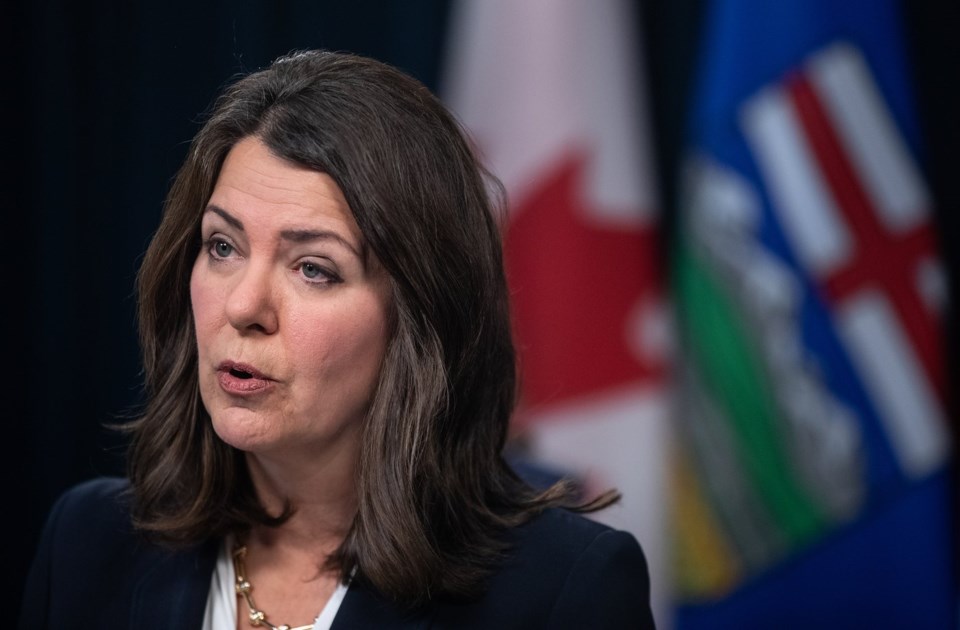EDMONTON ŌĆö Alberta Premier Danielle Smith says her government is making major changes to auto insurance, including allowing rate hikes and switching to a predominantly no-fault claims model.
Under the new system, car accident victims in most cases wonŌĆÖt be able to sue the party responsible for their injury and, instead, insurers would pay compensation at rates set by the government.
By cutting down litigation costs, the government estimates that when the new system is in place in 2027, it could lead to savings of up to $400 per year for the average insurance premium.
It's also promising better support and benefits for those hurt in collisions.
"This is a care-focused system," Smith told a news conference at the legislature Thursday.
ŌĆ£Instead of forcing people through complex legal processes in order to get the treatment that they need, the system default will be that those injured in collisions get the care they need to recover."
Until the new model kicks in, insurers will be allowed to raise rates for good drivers up to 7.5 per cent each year, starting in January.
The government said the hikes will help insurers pay rising legal costs and payouts along with covering off the impacts of natural disasters like hailstorms.
The 7.5 per cent cap is more than double the United Conservative governmentŌĆÖs rate increase cap of 3.7 per cent, which is set to expire at the end of the year.
Finance Minister Nate Horner said the term "no-fault" is misleading, because bad drivers will continue to pay more in premiums.
The province also rolled out some of the details of the new system.
Among the changes, crash victims will be able to sue at-fault drivers for pain and suffering if the at-fault driver is convicted of a criminal offence, such as dangerous driving or impaired driving.
If expenses go beyond whatŌĆÖs covered by the standard benefits, injured parties could also sue for out-of-pocket expenses.
The changes are similar the kind of litigation currently allowed in SaskatchewanŌĆÖs no-fault, public system.
The government plans to create an independent body to allow those injured in traffic accidents the ability to appeal decisions made by insurers.
Good driver rates won't apply for drivers who switch insurance companies.
Based on government-commissioned reports, the changes could lead to the loss of between 650 and 800 legal support jobs.
Jackie Halpern, spokesperson for the Alberta Civil Trial Lawyers Association, said in a statement the policy decision will be a loss for consumers and a win for insurance companies.
"We believe this policy will result in the worst of all outcomes: Albertans will pay more in premiums only to receive fewer consumer protections and lose their rights to challenge insurance companies in court," Halpern said.
Mark McCourt, an automobile accident injury lawyer and principal counsel at McCourt Law Offices in Edmonton, told The Canadian Press it's distressing for staff, including legal assistants, to know their jobs might be in peril, but it's far more devastating that Albertans will have their rights "confiscated."
"This no-fault product is going to be delivered by companies that are beholden to their shareholders - not to their injured policy holders," he said.
Horner said the province has the levers to make sure insurers comply with the rules.
The province has declined to move toward a publicly delivered insurance system, despite estimates it would save drivers even more money in premium payments.
Smith has pointed to prohibitively expensive startup costs approaching $3 billion for a public system, not to mention the loss of thousands of private sector jobs.
Horner said it's also about the four to five years his department estimates it would take to set up a public insurer, which introduces a new level of risk.
Alberta NDP Leader Naheed Nenshi said the price tag for setting up a public option is dwarfed by how much extra Albertans pay in premiums.
ŌĆ£(Smith) is basically saying, ŌĆśI don't want to spend the money, but you get to spend the money when you pay your premium every month,'ŌĆØ Nenshi said.
He said the UCPŌĆÖs solution will only lead to higher premiums, and accused the UCP of catering to business lobbyists.
The announcement come after two private insurance companies left the province this year.
Aaron Sutherland, a vice-president at the Insurance Bureau of Canada, told The Canadian Press removing legal costs to improve affordability and improve benefits makes sense.
However, he said auto insurers are going to continue to be forced to sell their coverage at a loss.
"The rate cap, even though it increased, continues to be well below the cost pressures underlying driver premiums," he said, adding that will reduce competition and choice, and ultimately harm consumers.
For his part, Horner acknowledged the rate cap won't make all insurance companies whole.
"We're trying to show the companies a path to 2027 that will somewhat stem the bleeding."
This report by The Canadian Press was first published Nov. 21, 2024.
Lisa Johnson, The Canadian Press


